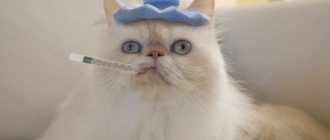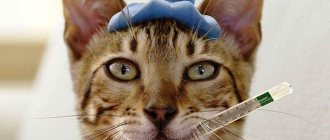How do you know if your cat has a fever?
You cannot tell if your cat has a high fever by a warm, dry nose, as many people believe.
The only way to know for sure whether it's a human or a cat is to take its temperature. Normal temperature in cats ranges from 38 to 39 degrees Celsius. Fever in cats occurs when the temperature rises above 39 C. While high temperatures can help fight the disease, temperatures above 41 C can damage internal organs. Contact your veterinarian immediately if your cat has a high fever.
Learn about the causes, signs and symptoms of high fever in cats, and what you need to know about taking your cat's temperature and caring for a sick cat.
What temperature should a cat be?
The most definitive way to tell if your cat has a fever is to take her temperature. A cat's normal body temperature is between 37.5 and 39.2 degrees Celsius. Temperatures above this range indicate fever
Ear thermometers are simpler and more convenient for pet owners, but as the Petcha website explains: “The best and most cost-effective way to take a cat's temperature is to use a pediatric rectal glass or digital thermometer. "Taking a cat's temperature at home requires two people: one to hold the cat and the other to insert the thermometer." Be sure to lubricate the thermometer with Vaseline and wait at least two minutes after inserting to get the most accurate result. Do not insert the rectal thermometer too deeply, as rectal tissue is sensitive and you may injure the animal. Also, never use a mercury thermometer because if it breaks, it can be very harmful to the cat's health and life.
While it's not the most attractive or convenient method, taking a rectal temperature is the best way to answer the question of whether your pet has a fever. If you are not comfortable doing this yourself, contact your veterinarian to have her temperature taken. It's also important to have your cat's vaccination records so your veterinarian can learn about any other diseases your pet may not have been vaccinated for to help narrow down the cause of her fever.
Symptomatic diet and procedures
If the temperature is high, then you can help your pet in the same way as a child. That is, apply cool, damp cloths to the main arteries (armpits, neck, inner thighs). Such procedures help well with banal overheating.
When the temperature rises, the animal should be given a lot to drink. Sometimes it is recommended to apply pieces of ice, but you need to be careful with this procedure.
If the temperature rises quickly and has reached high numbers, you should not apply ice. This may lead to seizures. In this case, the animal is prescribed special veterinary medications to reduce the temperature. In this case, the animal requires specific treatment.
In addition, it is worth remembering that a cat’s body becomes hypothermic just as quickly as it overheats. Therefore, you should not bathe your animal in a cold shower. You can't even pour cold water on it.
You can place your cat under a fan or air conditioner when his temperature is elevated. But again it is necessary to ensure that the pet does not become hypothermic.
An effective way is to use a weak vinegar solution. They lubricate the cat's pads about once an hour.
Echinacea tincture has also proven itself well. It is necessary to mix the tincture with water (at the rate of 1 drop per 1 kilogram of the cat’s weight) and give the pet this mixture.
A high body temperature in a cat is an unpleasant phenomenon, but there is no need to panic. It is necessary to observe the animal and try to reduce the temperature using folk methods. If the animal gets worse, it must be shown to a veterinarian.
Causes
If you believe your cat has a fever (or, to use the medical term, hyperthermia), your veterinarian will determine whether further testing is needed to determine the cause. Knowing the animal's medical history will be very helpful here. If you must see a different healthcare provider than one who already knows your pet, be sure to provide documentation of your pet's medical history, especially a list of medications, as cats sometimes have poor reactions to certain medications.
Just like in humans, there are many possible causes of fever in cats. The most common is a bacterial infection. Other likely causes are problems with the immune system or inflammation, exposure to toxins, a disorder or some kind of disease. It may be that the cause of your cat's fever cannot be determined, in which case you and your veterinarian can discuss next steps.
Causes of high temperature
Fever in cats is not a disease. This is a symptom that signals that something is wrong in the animal’s body.
We are accustomed to the fact that when the temperature rises, the forehead becomes hot and chills appear. But such signs are typical for people. But in animals this symptom manifests itself differently.
Before you look for the reasons for the rise in temperature and worry, you need to know what temperature is considered normal for a pet.
The norm is:
- 38-39оС - for an adult cat;
- up to 41°C - for an adult sphinx;
- up to 39.6°C - for a kitten.
An increase in temperature in a cat is characterized by the following signs:
- Refusal to eat or minimal appetite.
- Lethargy, weakness, apathetic state.
- Increased breathing, tachycardia.
- Trembling, convulsions.
- The animal is trying to hide from its owner.
- Dehydration sets in.
- The animal behaves strangely, its state is close to shock.
- Dry and hot nose (by the way, immediately after sleep, a cat may have a dry and warm nose, this is normal, but very quickly it becomes wet and cool).
You should immediately contact a veterinarian if the following are observed against the background of fever:
- The cat's eyes water, sneezing and mucus appear from the nose.
- Vomiting, diarrhea, or bloody diarrhea.
- There are hemorrhages on the skin.
- Shortness of breath and wheezing appear.
- Bleeding from the intestines, in particular from the rectum, is observed.
- The eyes and mucous membranes of the mouth turn yellow.
The danger of raising the animal’s body temperature is that serious qualitative changes in the pet’s metabolism occur.
Blood circulation is disrupted (this is especially dangerous for animals with heart disease), and the rate of oxygen delivery to the brain changes.
The animal suffers from loss of moisture and salts, this can cause convulsive seizures or excessive agitation, depression and fainting.
The main signs of high temperature in an animal are:
When the body temperature is from 39.5°C to 40°C the animal does not feel well. He has all the symptoms described. The pet needs to be taken to the hospital. When the body temperature rises above 40.5°C, the animal begins to become dehydrated and the pet’s condition is depressed.
If the body temperature exceeds 41°C, dehydration reaches a critical level, the functioning of internal organs is seriously impaired, and diarrhea or vomiting occurs.
Brain swelling, intestinal bleeding, and failure of internal organs may begin (accompanied by jaundice, the appearance of an acetone odor from the pet’s mouth, and anuria).
This condition can result in the death of the animal.
Experts talk about the following reasons for increased body temperature in cats:
According to statistics, 40% of cases of fever in cats are due to infections, about 20% of cases are statistically allocated to oncological and systemic pathologies, and about 10% are various diseases, as well as idiopathic (that is, with an unknown cause) fever.
Viral diseases that are severe for cats, such as calcevirosis and rhinotracheitis, occur with a very high temperature and are accompanied by purulent conjunctivitis, rhinitis, and indigestion. They require mandatory treatment by a veterinarian.
Any viral, bacterial infections and even helminthic infestations can occur with an increase in the animal’s body temperature. In this case, the cat usually refuses food, and there may be vomiting or diarrhea.
A reaction to drugs or substances toxic to animals may be accompanied by a rise in temperature, but other symptoms usually come to the fore: vomiting blood, refusal to eat, bloody diarrhea.
Allergies in the skin form or in the form of allergic rhinitis, bronchial asthma can occur with an increase in body temperature. Usually the temperature does not rise to critical levels and the owner pays attention to the animal’s coughing, sneezing, lacrimation and discharge of clear contents from the nose. Allergic pneumonitis can be accompanied by high fever, a specific cough, and a serious disturbance in the general condition of the pet.
Endocrine disorders are often accompanied by impaired thermoregulation of the animal. In this case, the temperature usually rises moderately. The animal's body weight changes significantly (obesity develops or the cat loses a lot of weight), the mood changes, the cat may be depressed, the animal may urinate or drink frequently, the quality of the coat may deteriorate, and baldness may begin. Tumors often develop against the background of hormonal imbalances.
An increase in general body temperature may be accompanied by post-injection or post-injection abscesses and mastitis in cats. In this case, the site of abscess formation is usually visible: a painful swelling.
Hyperthermia in cats can be due to simple overheating. During the hot season or if the owners heat the living space too much in winter, the cat may overheat. In this case, the animal breathes intensely and may have tachycardia. The cat cools itself with the help of nasal breathing, so the animal’s breathing quickens, it tries to more actively remove heat.
Body temperature in cats may increase during estrus. At the same time, the animal shows all the signs of “need for a cat.” Constantly meows, puts the croup down, and becomes depressed if her needs are not met.
Growing neoplasms, especially during the period of necrotization and tissue decay, are accompanied by an increase in temperature. At the same time, the animal actively loses body weight, its fur deteriorates, and digestive processes are disrupted. The cat may refuse food.
Cats may have neurogenic fever. That is, after stress (when moving, changing owner, and similar situations), the animal’s body temperature may rise; its peculiarity is that antipyretic drugs are ineffective in this case. This temperature is accompanied by a disturbance in the animal’s mood, but quickly passes when the animal calms down.
Treatment
In addition to rest and drinking plenty of fluids, antibiotics are commonly used to treat fever in cats. Getting your cat to take medications, as well as taking his temperature, is not easy, but it is very important. If he spits out the pill or doesn't eat the cat food you hid it in, use these great tips on how to give pills to your pet. One of them is to wrap the animal in a towel for its comfort and safety. It would be nice to get an assistant to cope with this non-trivial task.
In some cases, your veterinarian may recommend a liquid medication for hyperthermia, which is easier to give.
It's not easy to watch your fur baby suffer from a fever, but beyond the medical care instructions your veterinarian has prescribed, there are some steps you can take to prevent the illness from developing. Regular cat care (brushing teeth, trimming nails) and periodic checkups (checking ears, monitoring her eating and drinking habits) will help lay an excellent foundation for a healthy life for your pet.
And don't forget to hug the cat. A little love will help your pet get better faster!
Why do you need to consult a doctor?
An increase in body temperature can indicate a variety of health problems, so it is very important to examine your cat and make the correct diagnosis. After a visual examination, if obvious causes are not established, the doctor may prescribe additional tests: ultrasound of the abdominal cavity, x-ray of internal organs, determination of hormone levels, urine, feces, blood tests, etc. In some cases, consultation with highly specialized specialists is required, for example, an allergist, neurologist, infectious disease specialist, gastroenterologist, oncologist.
At the same time, the doctor corrects the cat’s condition, if necessary, prescribes infusion therapy to replenish lost fluid, and administers antipyretic medications. In severe cases, the animal must be placed in a hospital to ensure constant monitoring, maintaining the functioning of the kidneys, lungs, heart and other internal organs.
Prolonged elevated body temperature poses a serious threat to the life of animals, so a visit to the veterinarian or calling him to your home should not be postponed. Correct diagnosis is very important so that treatment is not only symptomatic.
Therefore, it is fundamentally important to show the cat to a qualified specialist. "Bio-Vet" is a professional veterinary clinic. Our branches are located in all districts of Moscow, in Reutov and Lyubertsy. We have doctors of all specializations working around the clock who will quickly provide competent assistance.
How to measure a cat's temperature
So, using a thermometer is the only reliable way to determine body temperature in animals. But which side to approach and how to measure a cat’s temperature?
There are 2 types of thermometers used for animals:
Ear thermometer
- Classic thermometer
- Ear
Classic thermometer
can be alcoholic or electronic. It is used rectally. You can measure a cat's temperature not rectally.
Ear thermometer
a more modern device, its use is less stressful.
How to take a cat's temperature rectally
- Have a helper help hold and calm your cat during the procedure. During temperature measurement, most pets behave calmly, but particularly temperamental cats may resist. It is better to entrust such animals to a veterinarian. An aggressive cat can cause harm to itself or its owner.
- Prepare a thermometer. It is better to use a veterinary or children's electronic thermometer. Measuring temperature with such a device is more comfortable and takes only 2-3 minutes.
- Wipe the tip with alcohol and lubricate it with Vaseline or Levomikol ointment.
- Raise your tail. Slowly, using a twisting motion, insert the thermometer into the anus to a depth of 2-3 cm. Hold the thermometer until the beep sounds.
- After the signal, do not rush to remove the thermometer. Make sure that the device works correctly and the numbers do not increase. On some models, the signal is triggered ahead of schedule and for an accurate result you need to hold the device in the rectum for another 20-40 seconds.
- Evaluate the measurement result and wipe the tip of the thermometer generously with an alcohol wipe.
How to Measure Temperature with an Ear Thermometer
- Calm the cat down. Let the thermometer sniff, show your pet that the device does not pose a danger. When measuring ear temperature, you can usually do without an assistant.
- Wipe the tip of the thermometer with an alcohol wipe.
- While supporting your pet's head, insert the thermometer into the ear canal. Most cats are indifferent to the procedure. Do not try to push the thermometer very deep, so as not to damage the eardrum.
- Wait for the beep and make sure the readings do not increase.
- Remove the thermometer from your ear and compare the result with the norm.
- Disinfect the thermometer tip again.
What can you do at home?
If the temperature rises slightly, it is not necessary to take any measures, but even this does not cancel a trip to the doctor. If your cat has a high fever, you can use echinacea tincture, which stimulates the body's defenses. There should be 1 ml of medicine per 1 kg of weight:
- The required amount of tincture should be mixed with boiled water (1 tbsp.).
- Draw the liquid into a syringe without a needle and forcefully give it to your pet.
- It is not recommended to use the product more than once a day.
Echinacea tincture stimulates the immune system
Additionally, you can use Regidron solution, which will replenish the fluid deficiency in your pet’s body and improve its well-being by preventing dehydration. 1 sachet needs to be filled with 1 liter of water and mixed thoroughly. The solution should be given 20 ml 3-4 times a day forcibly.
Rehydron replenishes fluid deficiency in the body
To reduce your pet's body temperature, it is not recommended to give non-steroidal anti-inflammatory medications: Ibuprofen, Nurofen, Diclofenac, etc. Such drugs can cause bleeding from the gastrointestinal tract, especially when taken on an empty stomach.
One day my cat got sick, which I identified by its characteristic signs. Kesha did not get up, and his nose was warm. In this case, due to lack of experience, I turned to my neighbor, an avid cat lover. In front of me, she measured the pet’s temperature by inserting a mercury thermometer into his anus. As it turned out, my pet had a fever, the cause of which was inflammation of the kidneys, which was clear from the animal sitting on the tray for a long time. In this case, treatment was carried out with antibacterial drugs prescribed by the veterinarian. Soon the cat felt much better, he began to play and run.
Traditional methods
To reduce your pet's temperature, you can use cool water to wet the animal's paws. However, you should never bathe a cat while sick. Cool water should be used not only externally, but also given to the pet internally using a syringe every few hours, 10-20 ml to prevent dangerous consequences.
If the temperature is close to 41 degrees, then it is recommended to wipe the cat’s paw pads with vodka or alcohol (it should be diluted half with water) every hour. For the same purposes, you can use 4% apple cider vinegar diluted with water 1:1. This procedure will ease the animal’s condition and help lower the temperature slightly.
Apple cider vinegar can be used to wipe your pet's paws
In extreme heat, you can apply ice wrapped in a towel to your pet's body, avoiding the abdominal area. This product should only be used urgently. It is not recommended to use it regularly. To alleviate your pet’s condition, you can turn on the air conditioning, but only to reduce the temperature in the room by a few degrees.
Some cat breeders recommend massage to relieve fever. It is necessary to feel the area under the knee bend on the outside of the hind paw. Then massage this area for 5 minutes. This area is responsible for thermoregulation and will slightly reduce the manifestations of heat.
Video: what to do if your pet has a fever
How do cats regulate their body temperature?
Thermoregulation refers to the control of body temperature as a result of external factors such as increasing or decreasing temperature.
- Change location : Move to a shady area if it is hot, move to a sheltered area or sun if it is cold.
- Vasoconstriction or vasodilation : Constriction or dilation of blood vessels to restrict or increase blood flow. The blood carries heat, which then reaches the surface of the skin. So, on hot days, blood vessels dilate to increase blood flow to the skin; on cold days, they narrow to reduce heat loss.
- Hair : Hair stands on end when the temperature drops, this improves the insulating properties of the skin and coat.
- Shivering : When the temperature drops and the above methods are no longer effective, your cat will begin to shiver. This occurs when the muscles begin to tremble slightly to produce heat, expending energy. Chills may also occur in response to a fever.
- Sweating : This is not as important in cats as it is in humans. Cats sweat a little through their paws.
Reduced body temperature in cats
If a pet's temperature is below 37C, this condition indicates problems in the animal's body.
Causes of hypothermia:
- depression, drowsiness, apathy;
- chills, muscle tremors;
- anemia of the mucous membranes;
- viral, bacterial diseases characterized by immunosuppression;
- malignant neoplasms;
- pathologies of the cardiovascular and nervous systems;
- chronic renal, liver failure;
- hypothermia of the body;
- bleeding.
If the temperature is low, the cat will look for secluded, warm places. The cat becomes inactive and depressed . The cat reacts reluctantly to external stimuli; slight trembling is noticeable. With a significant decrease in physiological temperature indicators (up to 36 degrees), metabolic processes and heart rate slow down, and blood pressure decreases. Breathing becomes rare and shallow. The cat is breathing heavily and wheezing can be heard. In veterinary medicine, such a condition is characterized as shock, so it is very important to provide assistance to your pet as quickly as possible.
Caring for a cat with a fever
Cats that show signs of fever for more than 24 hours or a temperature above 40°C at any time should contact a veterinarian. Your veterinarian can perform tests to determine the source of the fever and take steps to treat the underlying problem.
For example, if the source of the infection is a bacterial infection, antibiotics may be needed. Moderate or severe dehydration is treated with intravenous or subcutaneous fluids.
Never give your cat medication without the advice of a veterinarian. Some fever medications, such as paracetamol, are toxic to cats.
What to do if you have hyperthermia
To relieve fever and stress after heatstroke, wrap your cat in a damp, cool cloth and hide him from the heat. Next, you need to measure your body temperature. The measurement is performed rectally, so cats do not like this procedure. The pet is sensitive to the state of the owner, so during the measurement it is necessary to behave as calmly as possible.
Secure the cat with a soft towel and carry out the necessary manipulations without fuss. We recommend using an electronic thermometer, which quickly provides readings on a convenient display. This will help speed up the process. An ordinary mercury thermometer will have to be held for several minutes until the exact result becomes known. After the measurement, call a veterinarian at home or take the cat to the clinic for an examination.
If you live in Kaliningrad or the region, you are welcome at the branches of the Kaliningrad Regional Center for Veterinary Medicine. The doctors at our clinic will help your pet quickly return to normal. At the appointment, the veterinarian will perform an examination, determine the cause of the ailment and prescribe appropriate treatment and care. Each branch has a pharmacy for animals, which has everything you need.
Contact us: our animal clinic in Kaliningrad has experienced veterinarians and qualified care for your pets. We create ideal conditions for the recovery of pets and are always ready to help.










